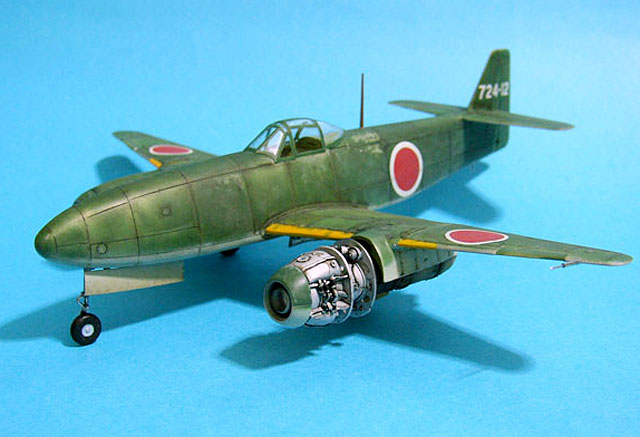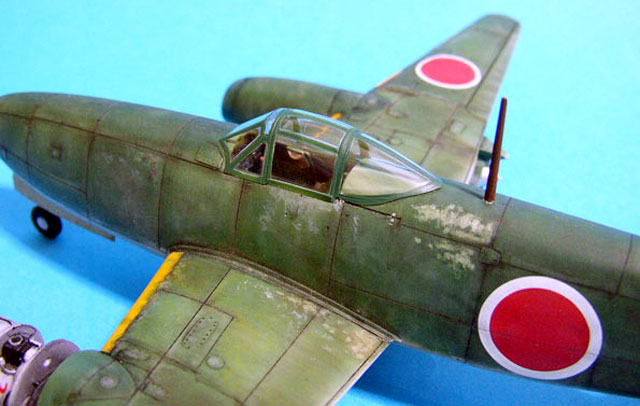|
Nakajima J9Y1 Kikka
by Francisco Carlos Soldán
Alfaro
|

|
|
Nakajima J9Y1 Kikka |

HyperScale is proudly supported by
Squadron.com
The Nakajima Kikka was the only Japanese jet plane of
the Second World War (the Kugisho Okha type 22 had to be transported by a
Mitsubishi G4M BETTY).
When Germany began flight trials of its first
prototype of the magnificent Messerschmitt 262, the Japanese Military Air
Attache in Berlin was witness to a number of flight tests. Thanks to the
enthusiastic reports of the Attache, the commander of the Kokutai of the
Nihon Kutei Kaigun, Japanese Imperial Navy issued a requirement in 1944 to
Flat the Greater General, in his 19-Shisaku (19° year of the Showa regime)
demanding a local fighter specifically for defence. Initially, the Navy
wanted a two-engine interceptor of short operational range; but the turn
of the events changed the demand for a defensive weapon for the Mother
country, destined to attack and to commit suicide if the situation
required it. That is to say, in western language, Kamikaze.
In September of 1944, the Navy ordered Nakajima
Hikoki K.K to develop to a single-seat twin engine airplane based on the
design of Me 262 (although some sources indicate that in fact a contract
under license for the construction of Me was signed 262, for which were on
board received the planes of a submarine, such as happened with the Sushui
J8M1).
The specifications were something less rigorous than
for the German fighter: Operational range: • 205 kilometers (127 miles)
with a load of of 500 kilograms (1,102 pounds) • 278 kilometers (173
miles) with a load of 250 kilograms (551 pounds); top speed of 696 km/h
(432 mph) Landing speed: 148 km/h (92 mph) Take-off run: 350 ms (1,150
feet) with the help of rockets of attendance to the takeoff.
The design had to include folding wingtips so that it
could be hidden in caves and tunnels. Emphasis had to be placed on the
fact that the aircraft would be assembled by inexpert manual labor.
Nakajima assigned the project to engineers Kazuo Ohno
and Kenichi Matsumura. Its design resembled the 262 at first look, but it
was smaller compared to the Messerschmitt. It was an airplane entirely of
metallic construction, with the exception of the fabric control surfaces.
Ohno and Matsumura designed the Kikka with motors under each wing, to the
way of the German jet. This characteristic allowed that the designers
proved diverse types of motor without having to redistribute the structure
of the fuselage.

With the Japanese industry surrounded by numerous
logistic and technical problems, the design of the motor was delayed.
Initially, the airplane had to be driven by a pair of Tsu-11 of 150 kgs of
thrust, motor type Campini (although entirely of independent Japanese
design), but these soon were replaced by two turbojets of also Japanese
design, two Ne-12 of 300 kgs each. Nevertheless, the Ne-12 could not give
the anticipated push, and the official interest in the Kikka began to
diminish because it seemed that it would not be possible to be solved the
requirements of benefits on time. However, meanwhile and luckyly, an
engineer found photographs and a drawing in cross-sectional section of the
German BMW 003 axial flow turbojet, and the Japanese technicians could use
these photos to help themselves in the design of a similar turbojet
(denominated Ne-20) of about 550 kg of thrust. It was decided to change
the Kikka to the Ne-20 after several attempts to perfect other designs
failed. Now it seemed that the requirements of benefits could be solved,
after all, and the project followed ahead with greater speed. The first
prototype left the factory the 25 of June 1944 for Kasukawa, in the
prefecture of Gumma.
Lieutenant Commander Susumu Takaoka was assigned to
the program, and from autumn she was prepared for the installation of the
new motors. The engines were fitted to a Mitsubishi G4M Betty specially
modified to serve as large bench test for the new powerplants.
The first flight of the Nakajima J9Y1 Kikka took
place on the 7 of August, a day after the U.S.A. dropped the first atomic
bomb on Hiroshima. It returned to try one second attempt four days later,
after Nakasaki had already been devastated by the second atomic bomb, but
aborted the takeoff and crashed in Tokyo Bay. This accident occurred
because the technicians had mounted the rocket assisted take-off bottles
at the incorrect angle.
The development of the Kikka ended four days later
with the Japanese surrender. Another prototype was almost ready for flight
and nearly 25 other Kikkas were in Nakajima’s factory in various stages of
assembly.
The fighter version was planned to be armed with 30mm
cannon. This version would have been powered by two Ne-130 of 750 kg or
two Turbojets of axial flow Ne-330 of 900 kgs.
I was hooked as soon as I researched the history of
this fascinating aircraft.
The Kikka, together with the Okha and the Sushui,
comprises of the trio of secret arms of Japan.
When I confronted the task of finding these scale models in the market, I
only found them in scale 1/72 by MPM. Of average quality in general, that
yes, with photoetched of detailed, are not that bad, but there are not
many options in any case.
I prefer to build in 1/48 scale, an especially wanted
to build the Kikka in this scale to complement my Me 163 Komet and Me 262
Messerschmitt . After much investigation, I managed to find the rare kit
in HLJ (Hobby Link Japan) released by the previously unknown (to me
anyway) company of Fine Molds. I ordered the kit without delay and waited
impatiently for its arrival.
When the kit was finally in my hands, I was
pleasantly surprised: the parts were finely molded, with engraved panel
lines; very fine and faithful details to the original plane; and with
detailing of the cockpit more than sufficient. The only disappointment was
the one-piece, closed canopy.

I went to work. I installed the cockpit, which I
painted using Tamiya Green mixed with a little Olive Green, to recreate
the color of Nakajima cabins. I rebuilt the instrument panel with
photoetched parts for the dials
Except for this, everything in the cockpit was built straight from the
box.
Some care must be taken with the wings to obtain the
correct dihedral.
Another important detail is the presence of a screw
that is fitted in the upper base of the well of the front undercarriage
(piece nº C27) that acts as a counterbalance. When I bought this model,
the option to display the Ne 20 motor did not exist, so I installed the
nacelles them without greater complications to the wing.
The only problem is the hollow which they
presented/displayed which shows the wing in this inferior portion.
Evergreen strips were used to address this problem. nothing that could not
be solved with fine plastic sections evergreen.
The area that is a genuine pain, however, is the
tail. This requires much filling and sanding, made worse due to the
requirement to maintain or recreate surface details in this area. At this
stage I left the Kikka and I embarked on other projects.
After some months, my interest returned when I saw
that HLJ was offering a new version of the FineMolds Kikka, but this time
with 20 Ne engines. On impulse I ordered it, wishing fervently to build
and detail the motor, since I believe that it is the first time that a
Japanese motor has been available to display in this scale.

My biggest surprise was when the kit was delivered
was that the new parts for the motor came magnificently represented in
white metal, and the nacelle in which it is displayed is a magnificent
resin reproduction. I removed one nacelle to install the new motor. In the
process, I damaged the trailing edge of the wing, which I had to rebuild
with plasticard, without major problems.
Model, Images and Text Copyright © 2003
by Francisco Carlos Soldán Alfaro
Page Created 29 October, 2003
Last Updated
17 March, 2004
Back to
HyperScale Main Page |
Home |
What's New |
Features |
Gallery |
Reviews |
Reference |
Forum |
Search